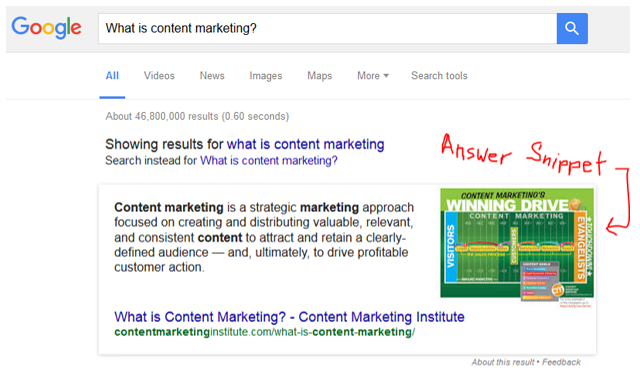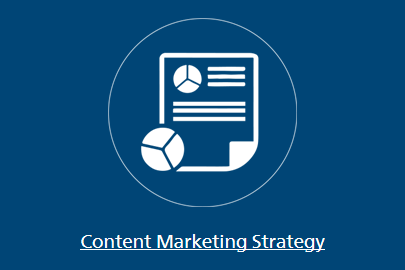Content Marketing is certainly not a new term or marketing strategy, but most marketers believe the importance of content marketing as a business strategy continues to grow. In fact, a recent poll of over 1,500 marketers by Smart Insights, showed Content Marketing as the Digital marketing activity that will have the greatest impact in 2016.
But while the majority of marketers agree on its importance, most also agree content marketing is very difficult to do well, especially for small businesses or organizations with limited people and resources. So, in an effort to help I’ve put together a list of guidelines or best practices for effective content marketing.
Kevin’s Rules for Effective Content Marketing
 Leverage
Leverage
 Start with Strategy – This may sound obvious, but many small organizations still haven’t thought about or developed a content marketing strategy. Start by defining your audience. Who are they and what type of content will they consume? What will interest them, help them in some way, or differentiate your organization from your competitors? Where will your audience (prospects, clients, influencers, etc.) find and interact with your content? How will your content support your organizational goals?
Start with Strategy – This may sound obvious, but many small organizations still haven’t thought about or developed a content marketing strategy. Start by defining your audience. Who are they and what type of content will they consume? What will interest them, help them in some way, or differentiate your organization from your competitors? Where will your audience (prospects, clients, influencers, etc.) find and interact with your content? How will your content support your organizational goals?
- Get Everyone Involved – Creating content isn’t easy and delegating all of your content creation to one or two marketing employees might not be the best approach. So think how employees at different levels and from different areas of expertise can get involved. Consider brainstorming sessions during meetings with execs. Talk to sales about questions they get often from clients and prospects and how content might support their needs. If project galleries or case studies are part of your content plan, think through how you can incorporate the creation of new content into your project management process. Not all employees will be comfortable writing content, but most can have some role in idea generation and content/information gathering.
- Develop a Content Calendar – Once you have thought through your strategy, including who is responsible for what, lay out your plan in the form of a content calendar. This will do two important things: a) keep you on task and b) hold people accountable for content creation. If you don’t make your calendar visible and assign specific tasks, content is too easy to put to the side when other priorities arise. I’ve see it in my own company, when people get busy and repeatedly put off blog writing. Making your calendar visible throughout your organization will make it important.
- Consider Your Site Map – Content marketing isn’t all about your website, but your website should be a significant component of your plan. Think of your website as your digital marketing hub – a place that should connect to all other marketing initiatives such as social marketing, email, apps, advertising, etc. If you are updating or designing your website (your hub), make sure you have the structure (pages, sections, etc.) in place to support your content plan and to promote that content on your homepage and throughout your site. Make sure you have pages in your sitemap, designed to support all your services and products, blog capabilities and flexibility for tagging, video sections, resources libraries for white papers, case studies, project galleries, and more. Simplicity and ease of use are definitely trends in web design, but make sure they don’t hinder your content marketing efforts.
- Support Your SEO Strategy – Content Marketing and SEO shouldn’t be looked at as different initiatives, but rather as part of the same broader plan that supports your brand and drives traffic. Effective search engine optimization requires understanding how your audience searches for and finds your services (keyword research, etc.) and it requires content related to those keywords or topics, as well as links back to your website. Effective content marketing drives SEO results, but also benefits from successful SEO. Strong content can make an even greater impact if it is optimized and gains greater visibility. As Neil Patel explains in this great article, SEO and content marketing work together, just like PB&J (peanut butter & jelly). That is why your content marketing strategy and planning should include or leverage keyword research and prioritization, when determining topics for content initiatives.
- Develop an Ongoing Content Plan – This item applies specifically to content marketing on your website, vs. content marketing on social sites or other vehicles. Working for a web development company, I view many websites that have lots of static content (lots of pages for example), but that weren’t built to easily promote and add new content. That is why, at Marketpath, we always develop a plan for current content on a new site, but also for future content marketing initiatives. We want to determine a high level plan for adding future content to the site and how that will fit into the website design and usability. We also want to make it easy to promote new content on the homepage as well as relevant sections throughout the site.
 Take Lenex Steel for example – they are fabricators of large steel buildings and structures throughout the Midwest and have beautiful visual content of their quality steel structures. When designing their website, we wanted to allow them to easily add new steel projects in the future, and to promote them on their homepage, but also to cross promote projects by industry and by the specific type of steel fabrication work for each project.
Take Lenex Steel for example – they are fabricators of large steel buildings and structures throughout the Midwest and have beautiful visual content of their quality steel structures. When designing their website, we wanted to allow them to easily add new steel projects in the future, and to promote them on their homepage, but also to cross promote projects by industry and by the specific type of steel fabrication work for each project.
- Tell a Story – Storytelling makes content interesting and memorable, which is what you want for your brand. People also like to share stories, compared with boring, informational content. So how do you create stories for your brand? Visual stories can be told with beautiful, quality images or infographics. Video is also a powerful medium that people love. Stories about your clients and how you helped them can often be the most powerful and influential, so figure out how you to use those stories in your content plans. Even better if the stories are told by the clients themselves! For tips about how to write a great story, check out this article by Philipp Humm.
- Be an Expert – Experience and expertise position your business as a leader in your field and provides credibility for your organization. That credibility dramatically increases your organization’s ability to convert prospects and grow your business. So as you as develop your content strategy and brainstorm ideas, consider how your content can position your organization and increase your credibility. For a consulting business, case studies or blog articles about relevant topics can show leadership. A construction company might have better luck showcasing a project portfolio of impressive buildings from different industries. Every organization is different, but if you wish to be successful – think credibility!
- Answer Questions – Answering common questions that clients and/or prospects have about products, services, or industry happenings is a great way to improve your service and position your company as “Easy to do business with.” For those reasons, answering questions can be a great component of your content marketing strategy. As an added bonus, Google also loves content that answers questions, because that content is helpful in producing the best results in their SERPs. In fact, Google recently added “featured snippets” that answer questions at the top of its SERPs (search engine results pages). See the example below where I asked the question, “What is Content Marketing?”
- Leverage Content Across Different Marketing Platforms – Creating effective content is not easy, especially for a small organization, so don’t just use it in one way or one place. Many of our clients blog as one of their main content initiatives. A number of them also use the same blog articles as their main email newsletter content. Their email newsletter will include a summary paragraph from two or three blog articles, with links to “read more” which directs them to the full article on their website. This way they leverage the same content across multiple marketing platforms, while also driving readers of their email to their website, where they will hopefully browse and view other content that they wouldn’t see if they read the full article in their email inbox. Other clients use blog articles and case studies as part of traditional magazines they publish. If you are going to take the time to create strong content, use it as much as you can!
- Share & Syndicate Content to Social Media Sites – Even though I see this quite often, I’m still amazed when an organization updates the content on their website effectively, but doesn’t share and syndicate that content anywhere else. Social marketing sites are the perfect venue for sharing your content, so make it part of your process to post new website content (blog posts, case studies, white papers, etc.) to your social sites. Followers of your social sites have already raised their hands, indicating their interest in your organization, so they are more likely to read your content. They are also more likely to share your content, creating backlinks to your site and improving both your visibility (traffic) and website optimization. Finally, you can also connect with industry influencers that further your cause by syndicating your content to their large audiences.
- Create an Idea Repository – Content ideas and topics are often difficult to come by in the spur of the moment. So get in the habit of capturing (writing down) your ideas as they come to you. And better yet, develop a process for you and your team to document ideas in one common place. Over time, your ideas will grow and be your main source for planning and creating your content calendar.
- Think Calls to Action & Conversions – Effective content will benefit your organization via increased brand perception, visibility, and engagement, but your ultimate objective is to convert your constituents. So don’t forget to include some type of call to action with every page and content piece. The specific call to action will vary based on both the type of content and where you are targeting them in your purchase cycle (research phase, buying phase, post purchase cross-sell or support, etc.), but there should always be some kind of call-to-action in mind that will further your relationship with your audience: follow, register, download, contact, buy, etc.
- Measure – Like everything else in the digital marketing world, you should develop a measurement plan for your content marketing, so you understand what is working or not working, and so you can adjust and improve your plan over time. I recommend starting with basic activity based measurements, including the amount and types of content you create and post to various platforms (website, email, social, etc.), as well as engagement metrics such as visits, page views, followers, click-through, etc. Ultimately, you should strive to measure conversion rates (registrations, purchases, leads, etc.) and which types of content drive increased business or ROI – but you need to start somewhere.
- Re-purpose Content – Once you get better at measuring your marketing initiatives, you’ll also understand which content has been the most effective or valuable for your audience. Instead of always starting from scratch, re-purpose that content and publish it again. Maybe it’s an old blog that drew heavy readership – update it with new information and repost it or re-write if from a different perspective, but with much of the same content. Or turn a series of blogs on a certain topic into a white paper. Or a white paper into an info-graphic. Don’t always re-create the wheel when you already have something that has worked in the past.
- Leverage Tools that Make Content Marketing Easier – Content marketing is hard work, even with the best tools around, but it is much harder if everything is done manually or with software that requires you to be a tech expert. So investigate a few tools and/or software packages that can make your job easier. Start with the basics, including a content management system (CMS) that is easy to use and powerful, an effective email marketing tool, web and SEO analytics, and social media management tools. Then you can move on to more advanced or niche tools, such as social analytics and listening, influencer and content creation, graphic creation, or others that meet you specific needs.
What Rules Do You Follow?
Now that you have read about my content marketing rules, I’d love to hear about your own. Please let me know what I’ve missed or share some specific ideas that have worked for you.
If you have questions about improving your content and digital marketing, contact us today.
 Leverage
Leverage  Start with Strategy – This may sound obvious, but many small organizations still haven’t thought about or developed a content marketing strategy. Start by defining your audience. Who are they and what type of content will they consume? What will interest them, help them in some way, or differentiate your organization from your competitors? Where will your audience (prospects, clients, influencers, etc.) find and interact with your content? How will your content support your organizational goals?
Start with Strategy – This may sound obvious, but many small organizations still haven’t thought about or developed a content marketing strategy. Start by defining your audience. Who are they and what type of content will they consume? What will interest them, help them in some way, or differentiate your organization from your competitors? Where will your audience (prospects, clients, influencers, etc.) find and interact with your content? How will your content support your organizational goals? Take Lenex Steel for example – they are fabricators of large steel buildings and structures throughout the Midwest and have beautiful visual content of their quality steel structures. When designing their website, we wanted to allow them to easily add new steel projects in the future, and to promote them on their homepage, but also to cross promote projects by industry and by the specific type of steel fabrication work for each project.
Take Lenex Steel for example – they are fabricators of large steel buildings and structures throughout the Midwest and have beautiful visual content of their quality steel structures. When designing their website, we wanted to allow them to easily add new steel projects in the future, and to promote them on their homepage, but also to cross promote projects by industry and by the specific type of steel fabrication work for each project.